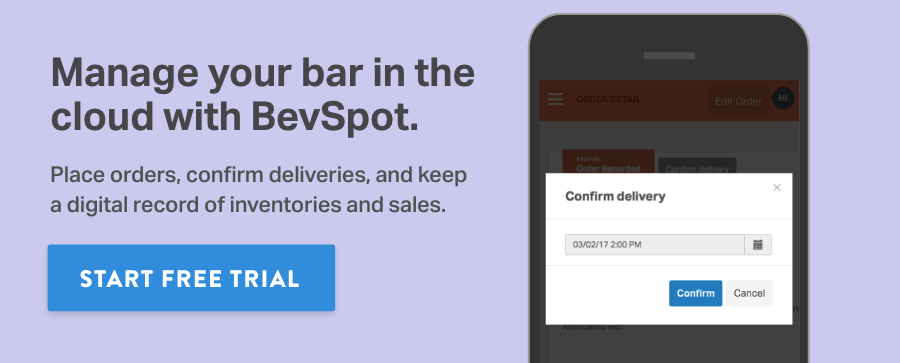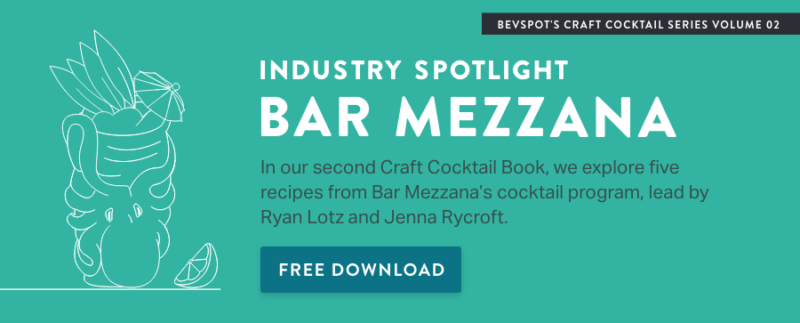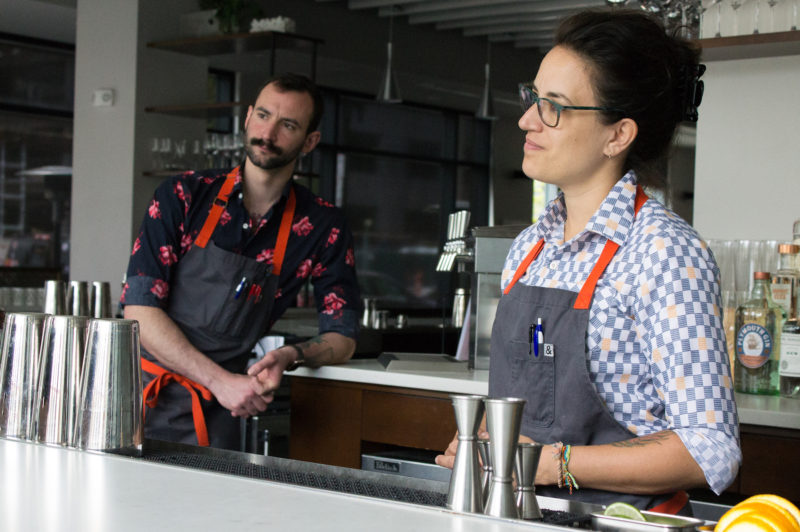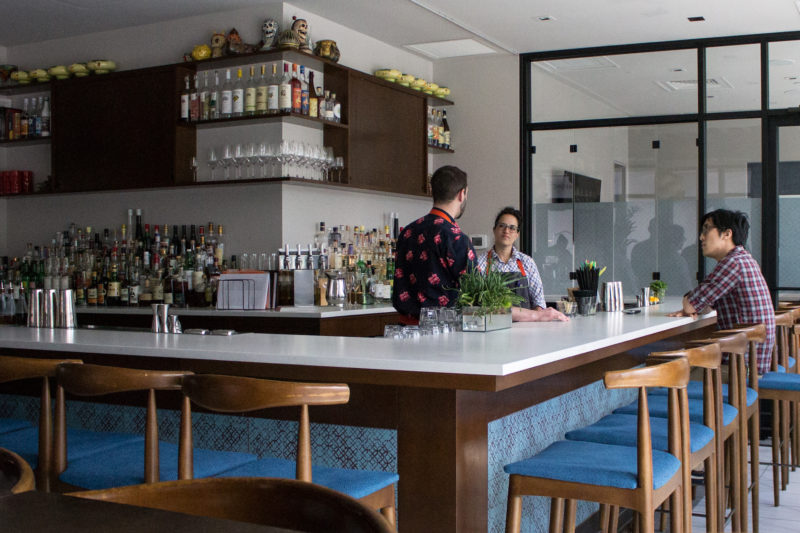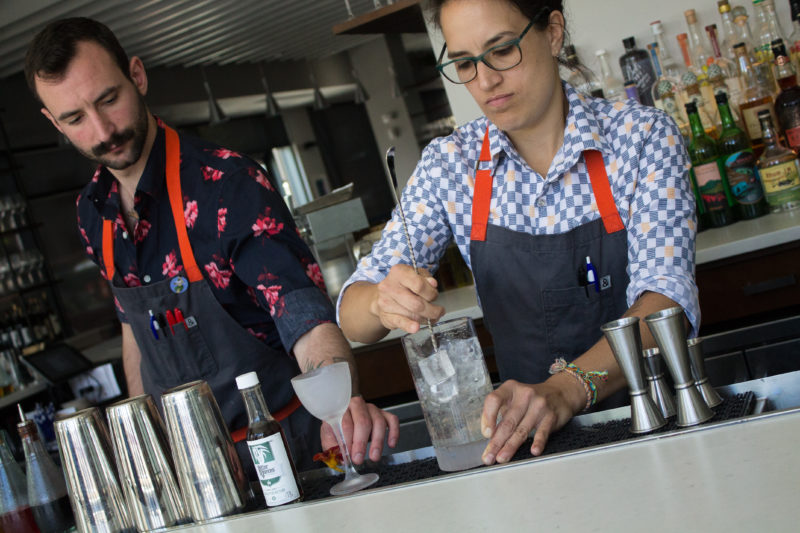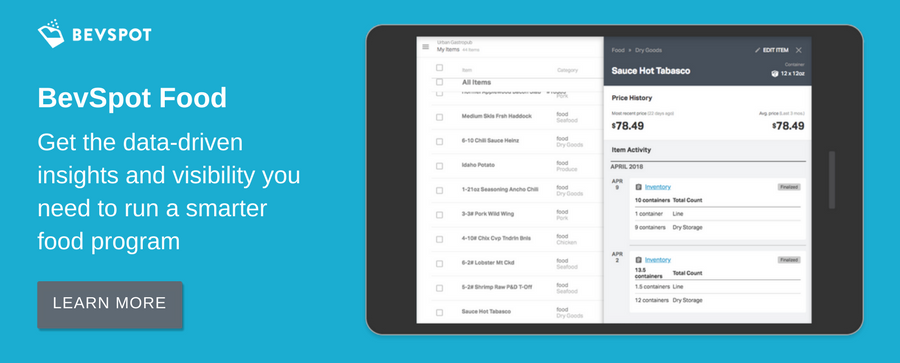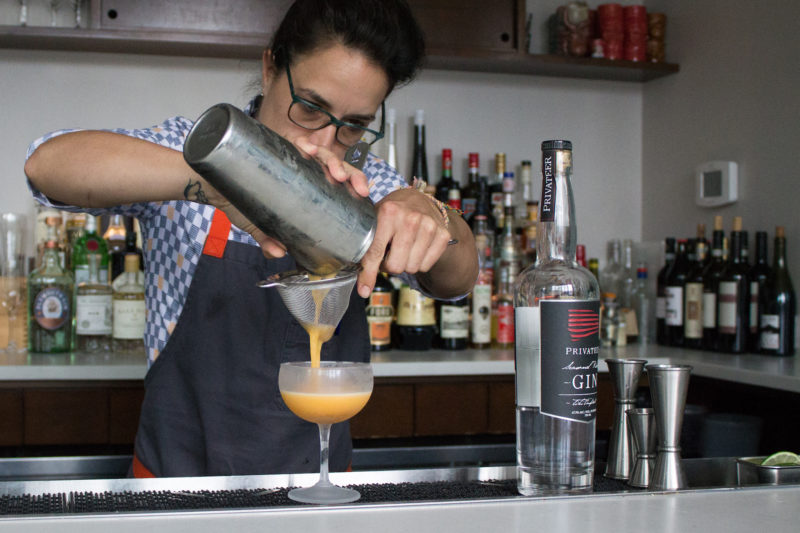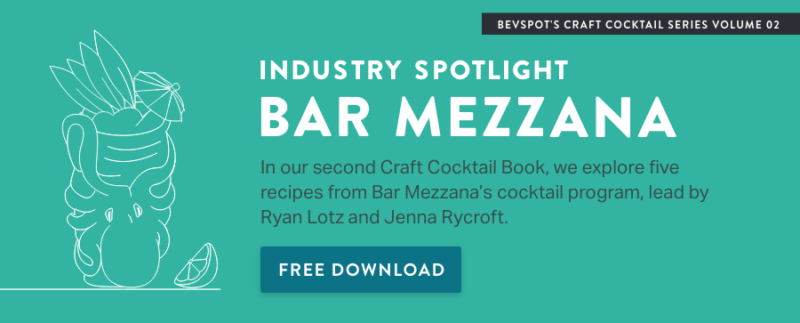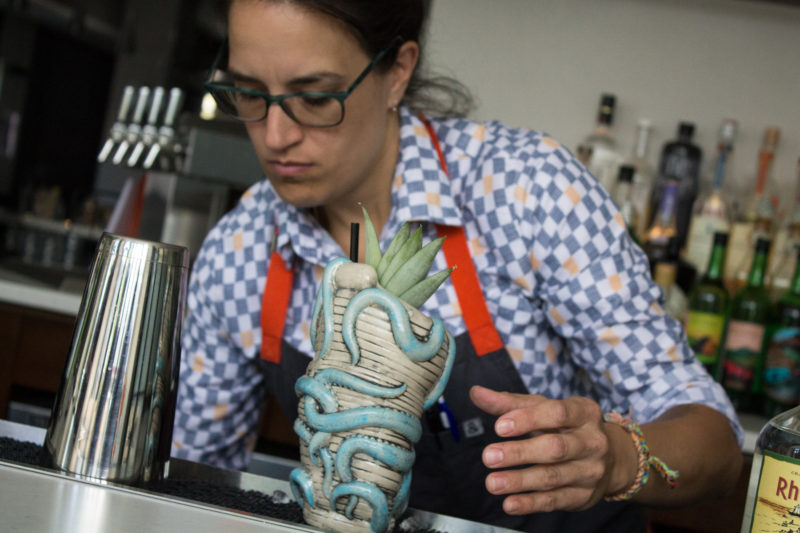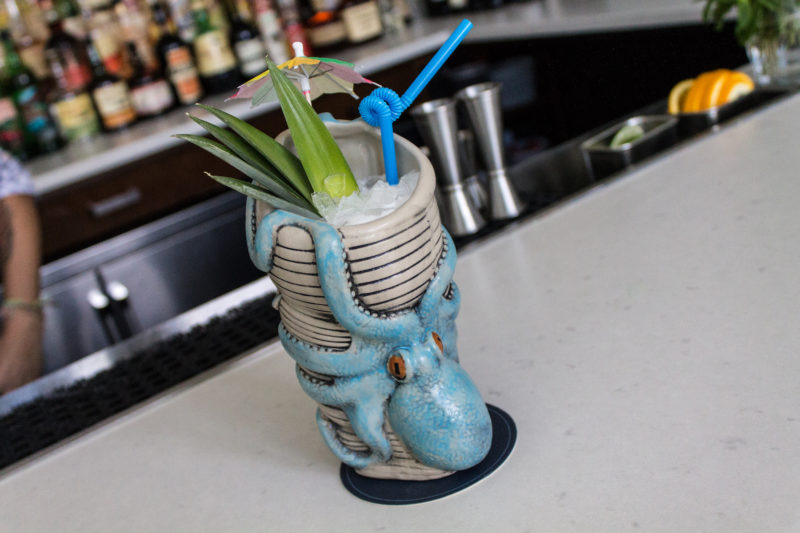The Most-Ordered Beer and Liquor Brands in Texas
Yearly Reports (U.S.): 2015 // 2017 // 2018
Regional Reports:
New York City, Boston, Chicago, Washington DC, Florida, and Texas
The history of The Lone Star State is steeped in separation from the rest of the nation.
But does that translate to Texans’ taste in beer and liquor as well?
Despite many often visualizing Texas as an arid desert filled with small country towns, Texas is also home to a number of thriving national metropolitan areas such as Dallas and Houston. Its culinary identity is often characterized and deeply rooted within traditional Mexican and American cuisine. However, some Texan establishments are also making waves within the industry and pushing the envelope in modern and creative offerings.
With all of this in mind, the landscape of Texas is made up of a curious blend of cultures and personalities. In our latest trends report, we take a closer look at our user base within Texas to see how their ordering trends might differ from those of the rest of our users.
The following material aggregates a year’s worth of ordering data ending in March 2017 from BevSpot users in the state of Texas. All figures represent percentages of orders in dollar terms.
Shipping Up to Pawtucket: Narragansett’s Mark Hellendrung
(featured image courtesy of narragansett)
Narragansett Brewery owner speaks out on moving back to RI, craft beer collectives, and the importance of staying homegrown…
Founded in Cranston in 1890, Narragansett Brewing Company is a Rhode Island institution and shares a name with a town, a bay, and a local Native American tribe. Since we first came of age to legally hit the bars, my peers and I have ordered ‘Gansett tallboy lagers—largely thanks to the friendly local price of $2-$3 a can (still typical a decade and a half later) and the taste compared to competitors in the same price range.
This was a few years before Mark Hellendrung, a former juice executive, led a team of local investors to purchase the company in 2005. His reasons for doing so have been written about many times: while hanging out at a bar in Newport, RI, Mark would hear patrons recount their favorite tales involving Narragansett and what the beer has meant to them over the years. Its affable, welcoming “Hey Neighbor, Have a ‘Gansett!’” slogan actually translated into real-life interactions in local towns and communities, and ‘Gansett has long held an identity as a homegrown, neighborly libation.
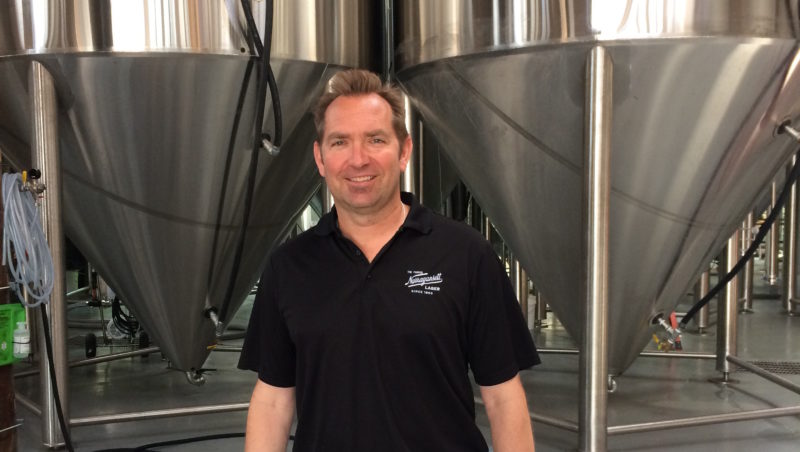
He realized that the lager occupied a very real place in the hearts of Rhode Islanders, but that, since the brewery production had moved out of state in 1982, there had been a disconnect between operations and the brand’s identity. “It had this fate at the time that I felt it didn’t really deserve, coupled with independence and being local—all of that really mattered,” says Mark. From the time they purchased it, Mark’s team knew they wanted to find a way to bring the brewery back to Rhode Island.
Another priority was revamping the lager recipe, which they did with help from Bill Anderson, who was the last brewmaster in the Cranston location before it shut down and production moved out to Rochester, New York. Bill recently passed away, unfortunately, but a decade or so ago, he lent his expertise to developing a modified recipe that still embodied the taste and spirit of the original as much as possible. The classic Narragansett lager and light lager are still made in Rochester due to the facilities required, and as the company grew under its new leadership, the target of moving kept growing and having to be pushed back. Meanwhile, in 2011, The Brewers Association changed its definitions of craft beer based on certain ingredients that could or couldn’t be in it, which made it more encompassing; Narragansett lager could now officially count as a craft beer once more.
About three years into the new ownership, the brewery started experimenting with entirely new craft batches. Mark shared with me, however, that this was far from its first foray: Narragansett created a porter during the 1920’s and a bock around the time of Prohibition, just to name a couple. As America collectively moved into the craft realm several years ago, Mark says, “as a steward of that movement, you become a historian of sorts.” The brewery boldly ventured into IPA’s, pilsners, summer ales, bocks, porters, and even more exotic varietals, like its Del’s Summer Shandy made with Rhode Island’s trademark Del’s frozen lemonade, or its popular Lovecraft series honoring famed Providence horror author H.P. Lovecraft. The series started with a honey ale in early 2015 and most recently its seventh chapter, and altbier called The Temple.
Sometimes, finding that balance between the traditional lager and all of the craft varieties can be a fine line to walk; “it sometimes has people confused asking, ‘What are you? I don’t really get it,’” says Mark. “But I think the fact that we do these great craft beers helps to set our lager apart.”
The homecoming dream was finally realized a few months ago, when Narragansett opened its new Pawtucket brewing location as part of The Guild: a brewing collective which includes Narragansett as well as Sons of Liberty Beer & Spirits Co., Devil’s Purse Brewing Co., Farmer Willie’s Craft Ginger Beer, and Newburyport Brewing Co. The companies share equipment, rotating through the 300-barrel tanks and packaging line, as well as a spacious, open tasting area perfect for events.
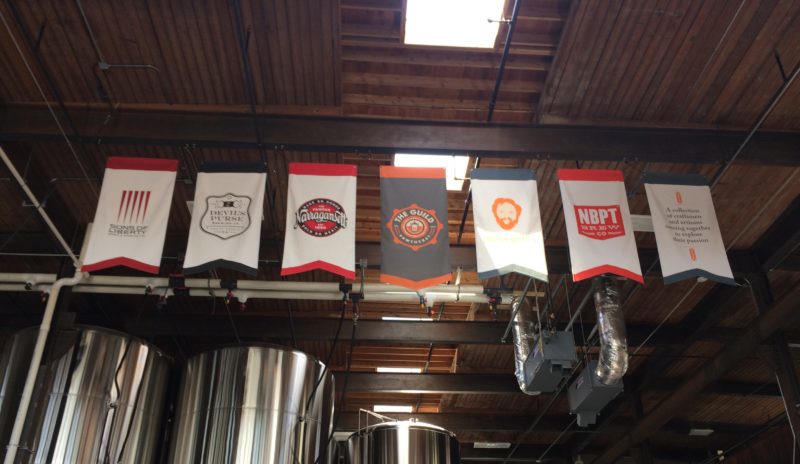
“The best part? The cans come out ice cold,” Mark laughs, letting me hold one for a moment to see for myself. He’s not kidding.
Scalability and manageable growth are priorities, but it’s more than that: “Rhode Island is only about 20% of our business now, but that’s the one we watch more than anything else,” says Mark. “It’s cool that we sell a lot of beer down in Tennessee, but I’m much more concerned about how much we’re selling in Newport, Providence, Pawtucket—that’s home, and if you can’t make it here then the rest is all kind of secondary.”
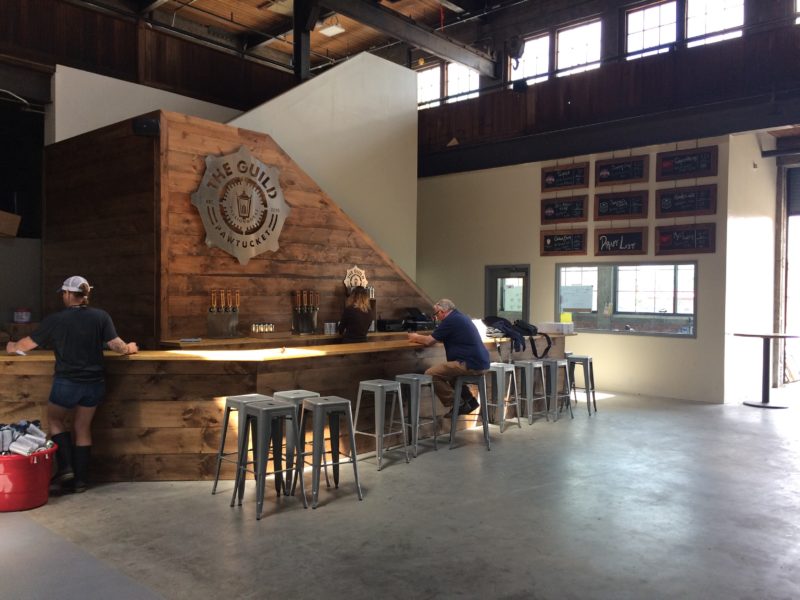
The Guild was crucial in realizing the homecoming dream, which “was kind of the exclamation point on the project and really important for the authenticity of the brand. The sentiment was, ‘We’ve gotta be brewing here in Rhode Island again,’” Mark shares. Teaming up with other brewers not only eases overhead costs; it also “creates something really special: a community almost like a farmers’ market, which gets into the whole spirit of craft beer,” says Mark. “None of us could have created this on our own, but collectively we could. It’s a totally new company.”
“We’re staying homegrown,” Mark continues. “We’re not selling out to the big guys. Everyone working here is so passionate about it; you couldn’t ask for anything more.”
For more industry spotlights, sign up for your own free BevSpot community account to get notifications on the latest articles and gain access to our exclusive industry guides and tools.
Pittsburgh Drinks: Making Drinking History in the Steel City
A comprehensive dive into Pittsburgh’s drinking and cocktail history reveals one as storied, fascinating, and, at times, lurid as any town from New York to LA.
In the past, we’ve both reviewed cocktail books and chronicled the drinking history of towns from Washington D.C. to Buffalo. Now, from the minds of award-winning journalist Cody McDevitt and legendary Pittsburgh bartender Sean Enright, we have the rare pleasure of shedding light onto a book that is both. Pittsburgh Drinks: A History of Cocktails, Nightlife and Bartending Tradition is not only a comprehensive history of 150 years of Pittsburgh speakeasies, clubs, and cocktails but also contains local recipes from bartenders young and old, famous and up and coming, from Enright himself to cocktail legend and Pittsburgh native Phil Ward.
Here’s a look at what we found within:
Drinking in Da’Burgh
In the run-up to Prohibition, Pittsburgh one of the most unabashedly liquored up towns in the country. Hundreds of speakeasies served patrons in locales ranging from darkened alleys to private penthouses to the coat sleeves of clever panhandlers. It’s a history that seems so audacious that it must belong to a pulp novel or crime serial rather than a history book, but tales of mafiosos, clever cops, brawling brewers, and of course crooked politicians flow freely from the pages of Pittsburgh Drinks like beer from tap line.
Enright and McDevitt walk us through the booming age of jazz clubs, through the fight to include women and people of color in bartenders unions, from heady times full of joy, verve, and drinking with celebrities to the more somber eras of World War II and how war abroad changed the way bars and clubs ran at home. We see how those changes in turn molded Pittsburgh into the beautiful and lively city that it is today.
We’re taken through the lounge scene, disco fever, Pittsburgh’s mid nineties craft cocktail resurgence, and how their resplendent craft beer scene is encouraging a rebirth of and growth in neighborhoods all over the city. It’s a thrill to learn the history of places we’ve loved to visit, like the Church Brew Works, a craft brewery and restaurant built out of a beautiful and sprawling cathedral, literally placing the beer they make on an altar. This is a book that takes a history that is fascinating to us drink nerds, and connects it to the larger story of the city it serves, and it creates a greatly fulfilling experience.
That said, it wouldn’t do to talk about only half of the book. Here are a few of the cocktails we sampled from Pittsburgh Drinks, sure to be the first of many.
The Fussfungle
One of the first famous custom cocktails to come out of Pittsburgh, the Fussfungle dates as far back as the late 1800’s. A drink that the Mayor of McKeesport, the town in which the drink was invented, preached against and which was said to start fights in church. This one continues our love of freshly making the ingredients in house, and happily provides a recipe for Burnt Brown Sugar-Molasses Syrup, which once prepared is added to Rittenhouse Rye.
The result is a spicy sweet blend whose bite, while still present, is somewhat masked by the sweetness of the sugar syrup. The brown sugar syrup pairs very well with the natural citrus and cinnamon of the Rittenhouse, and one can see its popularity soaring in as wet a town as pre-prohibition Pittsburgh. And as much a fan as I am of gin, the Mayor loses points for speaking against this wonderfully smooth cocktail with the unique and memorable name.
The Hattori Hanzo
Speaking of a love of gin, next up we have the Hattori Hanzo, whose eye-catching name and list of ingredients made this one a must test. Nowadays, Hanzo is probably most easily recognized as the swordsmith who crafts The Bride’s deadly blade in the Kill Bill movie series. Hanzo, however, was also a real historical man and legendary ninja who once saved the life and assisted in the rise of one of the last Shogun rulers of Japan.
This cocktail pays tribute to the name with the use of yuzu juice, a Japanese citrus that is less tart than the more commonly used lemon or lime. Additionally, sherry and demerara sugar are added to sweeten the drink and work with the tartness of crabapple cider. The resulting cocktail is sweet, lightly tart, and the fruity ingredients blend masterfully with the more caramel-like sugar in the raw along with citrusy notes of gin.
The Verdict
As someone who grew up in a former steel town whose fate was tied to the rivers that ran through it we Buffalonians, and I can wager people all across the nation, can find a lot in common with a city like Pittsburgh. It’s a town as ready to cut loose as it is to clock in. A city whose culture, while not always immediately evident to outsiders, reveals its rich breadth and depth with warmth, welcome, and aplomb.
Enright and McDevitt have here delivered us a brief view into that world, with its warts and wonders all laid before them. Pittsburgh Drinks may not be the weighty and powerfully built tome of say, The Death & Co. Drinks Manual, but the substance found within is, much like their drinks, every bit as heartening. It’s a drink happily and thankfully shared.
For more cocktail book reviews, keep up with the BevSpot blog by creating your own free community account. You’ll get updates on the latest articles as well as gain access to our exclusive tools and guides.
Schedule 15mins to chat with a product specialist
Start a FREE Trial Today! BevSpot offers full product education and account setup for all customers! No card Information needed!
The Most-Ordered Spirits and Beer at Italian Bars and Restaurants
What do people really do when they are in “Rome”?
If you didn’t already know, this week is Negroni Week, a time to celebrate one of the most iconic cocktails in the bartending world. As venues and establishments across the world use this time to help raise money for meaningful causes and stir up their own inspired versions of the Italian cocktail, we here at BevSpot thought that we would celebrate Negroni Week in our own way.
Being obsessed with data and providing helpful insights into beverage programs, we collected and aggregated the ordering data of our users that feature an Italian-themed beverage program. Let’s break it down.
The following material aggregates a year’s worth of ordering data ending in March 2017. All figures represent percentages of orders in dollar terms.
Webinar: Main Street Hub and BevSpot Present – Boost Your Profits
Tips to save you time and grow your business
Log on to any social media network, and one of the first things you’ll notice is how much people are talking about food and drinks.
For your local restaurant or bar, it’s easy to turn these buzz words into dollar signs!
“Often times, restaurant owners are so busy handling the day-to-day that they rarely have time to step back and identify very simple opportunities to increase efficiency and improve profits. This results in large opportunities for improvement with relatively small effort if the owner knows where to look,” says Rory Crawford, BevSpot Co-Founder and CEO.
With over 1.9 billion people using Facebook and 313 million people using Twitter, there are a lot current and potential customers waiting to hear from your business, boost your bar profits using social!
The State of Iceland’s Craft Beer: A Conversation with Skúli Craft Bar
How does the current landscape of craft beer in Iceland compare to the US?
During a trip to Iceland, BevSpotter Stephen Ngo had the opportunity to chat with Víkingur Kristjánsson, the general manager of Skúli Craft Bar.
Skúli has been open in Reykjavík since December of 2015. About a year and a half ago, the bar shifted focus to specialize in craft beer, which has quickly become popular in the country. Working with multiple local breweries as well as renowned brands abroad, Skúli has developed a solid reputation among both residents and tourists alike for their beer program.
In his conversation with Víkingur, Stephen was able to explore how the craft beer market presently looks within Iceland in relation to the States and observe how it is continuing to develop.
The following has been edited for clarity.
How would you describe the program here?
Víkingur:
We serve a variety of craft beers from Iceland, Europe and the United States. Because we’re an independent bar, we aren’t exclusive to any of the big brands, and get to work with the product that we like. That means we can explore partnerships with a lot of different brewers.
Right now, we have a big collaboration with the Borg microbrewery here in Reykjavík. They have helped us since the beginning and we’ve been doing collaborations together like tap takeovers. We also feature seasonal craft beers through them.
We’re also a certified Stone bar in Iceland, so we always have a nice selection of Stone on draft. We work a little more with Stone Berlin at the moment. They’re doing great things. Some say they’re maybe better than San Diego, but it’s the same company. [laughs] They are one of our favorites.
We don’t serve food for now, because of the lack of space that we have. We are more of a pub than a bar. We just invested in a food truck.
So people can have food if they want to.
Exactly. For this summer, we’re going to try to have food outside the bar, but you can eat it inside too. Hopefully, it’ll be a good summer. Sometimes it’s difficult to hope for nice weather in Iceland, but we do get it sometimes. [laughs]
How much beer do you have from Iceland as opposed to outside?
We do about 50/50, 50% international and 50% Icelandic. Lately, we’ve been working more with Borg and less with other breweries. But now, the craft brewery scene is Iceland is growing really fast. So we recently made the decision to be more open to other breweries as well, even if they aren’t as recognized as Borg.
For example, we just began working with two other Icelandic breweries: the Brothers Brewery from Vestmannaeyjar (or Westman Islands) and Ölvisholt Brewery, which is just outside Reykjavík.
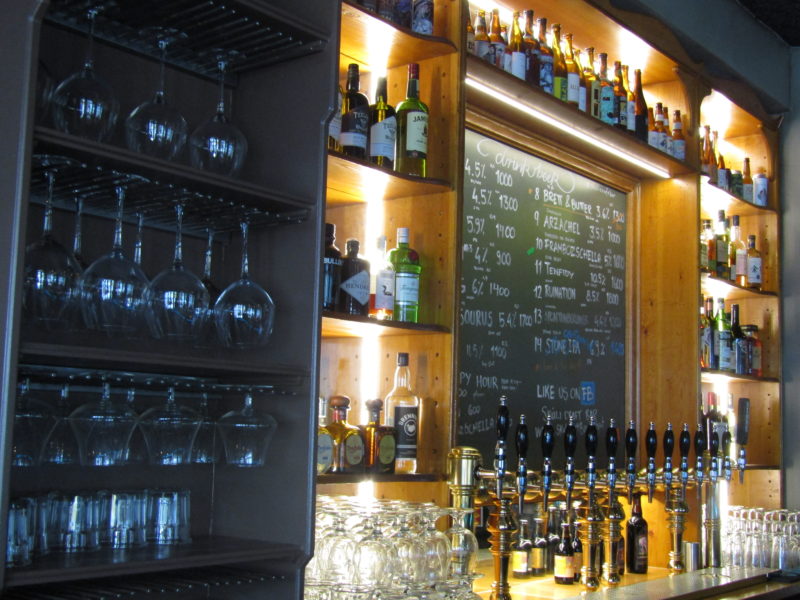
How quickly is craft beer in Iceland growing?
Really fast within the last year and a half. Five years ago, we had a really big boom of craft cocktails. Everyone started to make them and we had cocktail bars opening in Reykjavík. They were a fine-dining style if you know what I mean. From there, the interest of the customer started to develop and change. They wanted more. The beer trend started to follow it really fast.
It’s still an issue that you’re not allowed to brew at home.
What makes the beer world fantastic in the States is that everyone is brewing at home. You can go somewhere and try some beers from someone else. In Iceland, it’s not legal to do it.
It’s actually a bit of a gray area. You can do it as long as you don’t sell it. But, you have to get a certificate and license to sell it. You have to start a company. It’s a big investment, especially if you’re just two buddies who brew their own beer in the basement.
Now, we have three new breweries in Iceland that we’re going to collaborate with this summer.
Three new breweries on top of how many exist right now?
We have two big breweries in Iceland. They are like Budweiser in the States.
Gull and Viking.
Yeah. We have Gull, which is from Ölgerðin. They are the biggest distributor in Iceland. They distribute products like Pepsi. They are also the father company of Borg. They started the Borg microbrewery that followed up on their initial concept.
Then you have the other company that produces Viking, which is Vífilfell. They also produce beers like Thule.
Then you have a third one that is closely followed by the craft beer world and getting better and better, which is Kaldi. They are based in the north of Iceland. They brew lager, dark lager, and IPA. They brew porter as well sometimes. They do quite good stuff.
Then, you have Gaedingur, which also owns a beer bar here in Reykjavík called Micro Bar. Really good guys over there. We’re really good friends and we collaborate a lot. They do good stuff as well. Those are the brands that are known at the moment.
Now, our friend, Magnus, is opening a guesthouse/brewery/pizzeria. You can go there, have pizza, and try their beers. You also have a brewery opening down in the south of Iceland. There are just more and more. Putting all of those together is starting something.
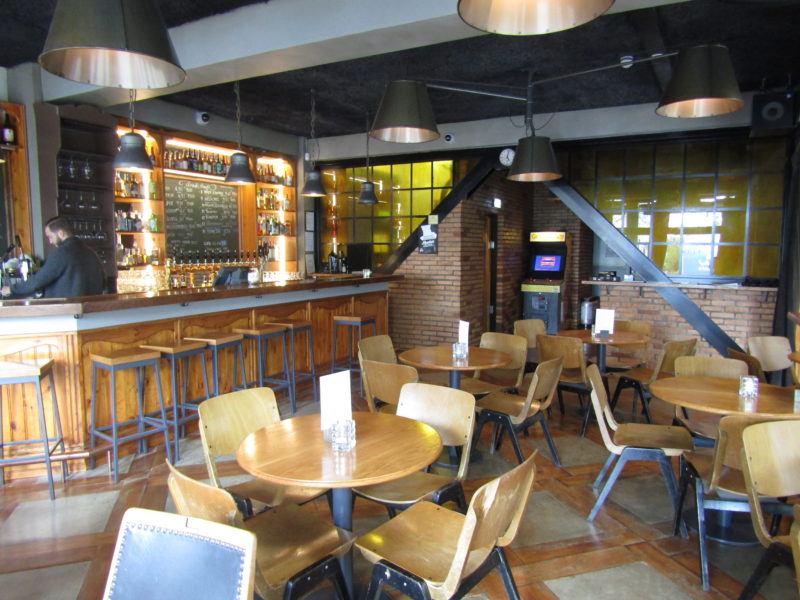
Do you think the consumer taste has changed and this is why all these places are coming up?
Yeah, 100%. They are more interested in it.
For them, the beer is not just a beer. They look for a certain standard and quality in what they are drinking. We’re still fairly new to that in Iceland.
Alcohol was banned until 1989. We always had breweries here in Iceland, but it was more that it wasn’t legal, so you tried to brew at home to have some alcoholic beer. Otherwise, you had to take spirits from the government, to make a 2% ABV pilsner. That’s pretty much the way things were done at the time.
So, it’s a new cultural thing in Iceland to drink, also to drink during the workweek. Usually drinking was just about getting wasted.
You are mentioning all of these new breweries that are now popping up. Previously, it must’ve been difficult for other Icelandic bars to create the beer program that you and Micro Bar have. Do you ever have to push very hard for specific beers? What is it like being a beer bar where the depth of selection is just getting started?
You have to build up connections. That’s really important. In Europe, it’s actually easier for us to get the product. In the States, it’s much bigger and the scene is bigger as well.
First, we do collaborations with distributors. Our main distributor has a big connection with Founders and Stone. They also work with Mikkeller, the Danish microbrewer that also runs the Mikkeller & Friends beer bar here in Reykjavík. Through Mikkeller, you can get a lot of brands like Evil Twin. They open you to another market. Because you collaborate with Mikkeller, you can have all the Danish beers and Omnipollo from Sweden. They have a big market.
It depends on us as well. Recently, for the first time, we’ve imported our own beer. We featured Birrificio del Ducato and did a tap takeover. It would be great to do that four times a year.
It’s still a big issue that beer is so expensive to import. We have to pay a lot of taxes for it. If it’s 4.5% ABV or lower beer, it’s no problem. But, a lot of the stuff we get are higher than 4.5%.
It’s more and more expensive. You have to pay taxes on the weight, the percentage of the alcohol, and the quantity. We have friends and customers, maybe coming from the States, who look at us selling glasses for $25 and being like “What are you doing, man?” That’s just how it is in Iceland.
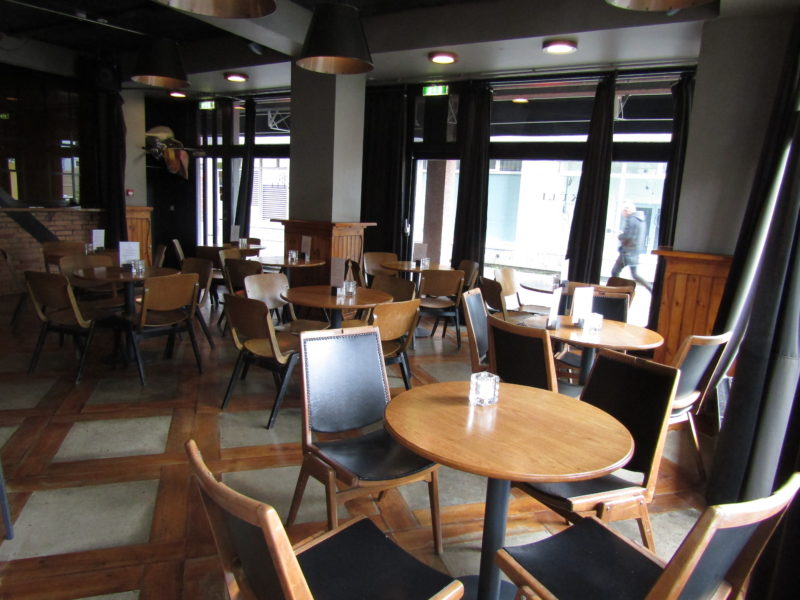
How do you decide which beers to feature for a tap takeover?
It depends on how far we can get. It happens a lot just through talking and meeting people at the bar.
What kinds of people?
People in the beer business.
Someone will say, “I’m a brewer or I know this brewery pretty well.” We’ll be like, “Wow, that’s awesome, can we talk about it?”
Then we’ll chat through email. If they like what we do and they fit the standard we’re using, we’re already one step closer to collaboration. By any chance it works out, we’d love to do it. We already do tap takeovers from the distributor and their partners. That’s what brings the standard for these collaborations.
How about the rest of your beer selection? What do you look at to decide what to put on tap?
For beers on tap, we try to have a balance between sours, stouts, and IPAs. We also have a standard lager and pilsner.
With IPAs, it can be more difficult, because they run out much faster. We tend to connect them once they get in the door and we try not to let them last longer than a month in-house or three months in the keg, so we can try to work with fresh ones.
We always tend to offer at least two darks all year long. During the winter, we can bump them up to three. During Christmas time, we actually bump them up to four.
Now, during the summertime, we usually work more with wheat beers and summer ales. Right now, we have two 3.5% ABV wheat ales to offer something lighter for people during the day. We always try to offer the guest everything that we can, but we always have the standard of seven Icelandic and seven international beers.
I know you probably have a lot of tourists coming in here. Since the craft beer scene is so new in Iceland, do you feel like you have to educate your Icelandic customers on these beers?
We have a small group of regulars. Most of the guests who come here know a bit about beer, trying things at home with friends. They’ll have some basic knowledge. Luckily, they trust us. They will tell us their preferences for hoppiness and things like that and we can make recommendations from there.
We always try to have a service that is friendly and easy-going. Nobody wants to feel ignorant or look stupid next to your friends going to the bar. You’re going to the bar to enjoy your time. It’s the same thing with all the spirits. We don’t want to take people too far out of their comfort zone.
What advice would you have for others starting their own beer program?
I would recommend to be open. It’s quite easy to have a cocky attitude, to say that I have a beer bar, I do beer and that’s it. Just don’t go there.
You have to remember that it’s about hospitality. If the person isn’t here for the beer, please them. You have to make them feel comfortable. After that, you can worry about your beer selection. You want to make them feel welcome to come back. Take the time to teach them what you are offering.
Is there anything about craft beer in Iceland that people in the States should know?
We’re getting better. We’re growing.
For more insights on beverage industry culture, sign up for your own BevSpot community account to get notifications on the latest articles as well as gain access to exclusive tools and guides.
Fortnight: A Local Wine Bar Making Industry-Wide Innovations
A look into the creation of a Providence wine bar and into the reasoning behind their unique model of operation.
After noticing a vacant niche in Providence’s bar and restaurant scene, three friends got together and worked hard to create their shared dream: Fortnight, a new establishment which soft opened downtown in December 2016 and officially launched in January. Although known primarily as a wine bar specializing in natural, biodynamic varietals, Fortnight also boasts an exceptional beer list, an array of spirits, and delicious small plates.
Fortnight is also carving out new turf as one of the first, if not the first worker-owned co-ops in the beverage service industry nationwide. Sustainability, thoughtfulness, and a passion for fine beverage and food are reasons why Fortnight has already attracted a devoted regular clientele, but there are many other attributes that make this airy, welcoming spot unique.
The Dynamic Trio
Longtime friends Elizabeth McDonnell and Chris Norris-LeBlanc both had day jobs, and Mike da Cruz had graduated law school but didn’t want to become a lawyer. The three, who met through Brown University, had been getting together for years to cook and drink, and the topic of opening a bar someday came up in conversation regularly. Although dreams are common, having the will, plan, and resources to actually implement them is less so.
“We’re not getting any younger, so we’ll either do it now or we might as well not bother,” says Liz. “Our lives weren’t getting less complicated as we moved forward.”
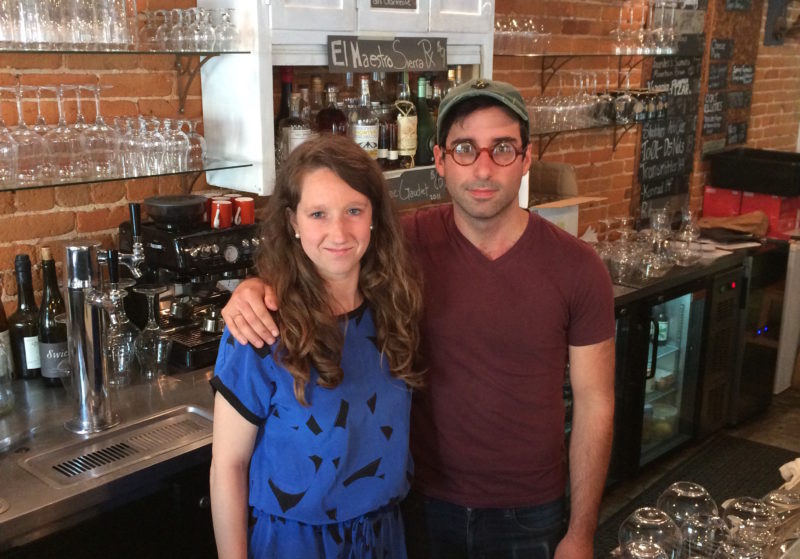
Because Providence is known for having so many exceptional restaurants, the trio knew from the start that they wanted to open a bar instead. It took six to eight months of searching before the old Aruba Steve’s building downtown became available; previously, they envisioned opening up on the West Side.
“Downtown was a different thing than we had originally conceived,” says Chris. “We were going to be on the West End and be super chill and open a little later only four nights a week. Opening downtown thrust us into a position where we had to be much more serious.”
The three first-time bar owners spent many long night tiling floors, building tables, and installing the bar top themselves in order to get the space ready to open. Liz, a graduate student, had no prior experience working in the food or beverage industry. Mike had only worked selling wine in Brooklyn for a couple of years post-college. Chris, a teacher by trade, grew up working for his family’s restaurants and catering services, then occasionally running a small pop-up restaurant out of his house as an undergraduate, and then at local restaurant Julian’s for a few months post-college. He is also a home brewer and does a lot of beer traveling and tourism.
Overcoming the Odds
Despite their limited industry experience, the team made it work through their shared passion for great food and drink. Even with a lack of advertising, word of mouth spread like wildfire in the community about the wine bar and its practices. While I was there early in their evening shift, Fortnight’s bar stools filled up.
The bar brings in guest bartenders weekly, usually vintners and importers, which helps to mix things up and to get the word out about different and exciting wines. Patrons enjoy chatting with the special guests, and the place is usually packed.
Building a Working Model
Aside from their shared passion for great food and drink, the roots of Fortnight’s operating approach can be found through the three’s participation in social justice organizing and advocacy work through Brown, attending many protests.
“We’ve all sat in the public safety complex,” Liz jokes. “It started to feel disempowering to the kind of organizing was doing… there’s all this in-fighting among leftists. So, we built a place that could be run the way we wanted to be run.”
Chris echoes her sentiment: “I had thought for a long time that the idea of a workers’ cooperative, a worker-owned business is the kind of thing I want to be involved in—hopefully someday primarily. [The three of us] all share a belief that that’s the right way to organize.” A potential fourth candidate is also currently being introduced to the co-op, and more might join in the future.
Balancing Food Acts
Initially, having three partners was valuable to the owners.
“There’s always a tie-breaker,” Liz says, although she also notes that there have been no truly major disagreements between her, Chris, and Mike.
She wasn’t sold on the name Fortnight two years ago, but “it stuck.” The word fortnight evokes a feeling of seasonality and harvest, according to Chris, which is especially relevant given that the bar offers a constantly-rotating menu of small plates, which changes so often that there is no written menu at all. All three enjoy cooking and bring in different dishes, so having an endlessly-innovative menu keeps them interested and engaged. Fortnight also has a zero-waste policy, which reduces overhead to keep prices down and is accomplished by making food that “gets better over a couple of days”, like goat rillette and Tuscan pomodoro soup.
“Because it’s not a restaurant we don’t have to make a ton,” says Liz. “we make enough for a few days and then rotate. The only food wasted is what someone leaves on their plate, but then I take that home to my chickens.”
Aside from the sustainability and financial benefits, the rotating menu serves another purpose: it encourages communication between patrons and bartenders.
“It was a much-beleaguered but intentional decision to do our menus this way, but the result has been that you have to talk to your bartender and have a conversation,” says Chris. “So, if you come in every two weeks and the menus are totally different, you’re always engaged in that process. I think it’s worked out really nicely and brought a lot of really thoughtful people into the bar.”
Hops & Grapes

Beer is also carefully curated—mostly sours from places like Belgium but also areas one wouldn’t normally expect, like Austria and Norway.
Chris notes that, “Sour beer is a big thing in most major U.S. Cities, with bars that are very specialized and take that on, but it didn’t seem like anyone had picked up that gauntlet here, so it’s something I’m trying to do. It’s cool to be able to put so much time and energy into something like a cellar list.”
He’s excited about the bottle program the bar is working to roll out: a couple hundred wines and maybe 60 or 70 beers. In addition to the bottle list, new developments in the works include outdoor tables, a new sign, and hosting more sit-down ticketed dinners.
Lessons Learned
When asked if she has any advice for someone wanting to open up their own bar, Liz responded, “My advice is to just do it. The timing couldn’t have been worse, and we didn’t have any money; we didn’t want bank loans, so we did grassroots fundraising of very small loans from our friends, between $500 and $5,000. That way even if we failed, we weren’t hurt by having a really big loan, and no individual was hurt by contributing a small amount. We do sell spirits, but we don’t do cocktails because we want to keep overhead low and there are already great cocktail bars in Providence. We built everything by hand, but we just figure out how to do it and we do it.”
For more articles that explore the culture behind the industry, sign up for your own BevSpot community account to get notifications on the latest posts as well as gain access to exclusive tools and guides.
Hold The Line: On Proper Maintenance of Your Bar’s Draft Lines
Cleanliness, like a good draft beer, is next to godliness.
Outside of the drink menu, there’s one important question every bartender should be able to answer confidently whenever asked: how often do you clean your bar’s draft lines?
Ideally, this is a question that should never come up, because every beer line should be dispensing clean and perfect beer. Cleanliness doesn’t just happen on its own though. Below are both the reasons for cleaning and dangers of a dirty draught line, and how to go about making sure your bar never has to worry about them.
The Virtues of Cleanliness
Beyond just the knowledge that your bar is being run well and being clean, there are a few clear benefits to keeping your tap lines well maintained. The most obvious of these is the fresh, and correct for that matter, taste of your beer. Every craft beer is taken through sample batch after sample batch, tinkered with until it reaches the desired level of perfection. A clean tap line will deliver that beer to your patrons in the state it was intended. A poorly maintained tap line will deliver any or all of the following problems:
Yeast & Mold Buildup
White/Grey growth found on faucets, couplers, drains, and other parts exposed to air. It looks gross, is potentially unhealthy, and will likely cost you both sales and reputation. Good beer and weird stuff growing out of the place it comes from do not mix.
Beer Stones
Calcium deposits that build up over time from the raw ingredients of beer. Not only can they have an affect on the flow rate of your taps if they build up enough, but they can also flake into the line over time, impacting the taste of the beer. Also, nobody likes to find mystery flakes in their pint glass.
Bacteria
Most bacteria that builds up in beer lines isn’t of great harm to human health. What it will do is completely despoil the look, aroma, and taste of any beer. A build of diacetyl will leave beer tasting buttery, while acetic acid will give beer a sour and vinegar-like taste. Other problems include a clouded color in the beer, and a smell of rotting eggs. So even though it may not turn beer toxic to humans, it will become toxic to your sales and reputation.
Beyond making sure your lines deliver clean and delicious beer to patrons, it isn’t unheard of to have representatives from craft brew companies stop into bars selling their wares to test them and make sure they’re being presented properly. Keeping everything clean not only keeps customers happy, but potentially distributors and brewers as well.
Flushing the Lines
A good rule of thumb, and rule of law in certain states, is to clean your lines every two weeks, or every half keg, whichever comes first. You can do this by either hiring out an independent contractor, or doing it yourself. Either way, be sure to keep a log as it is something most health inspectors will be looking for.
To clean the lines yourself:
- Uncouple all of the kegs from their lines, and disassemble all of the faucets and handles as well.
- All of the lines then need to be coupled together.
- Once coupled, the lines need to be flushed with cold water to remove any traces of beer still in the lines.
- Afterwards, a warm (about 90 to 100 degrees fahrenheit) caustic solution (many approved and specifically made cleaning solutions are available online) must be run through the lines for a minimum of twenty minutes to break down any bacteria in the lines.
- In addition to this two-week regular cleaning, an acid cleaning should be done every quarter to break down beer stones and other hard buildup in the lines.
- Once the lines are properly soaked and cleaned, they must then be rinsed with cold water to rid the lines of any remaining cleaning solution.
- To ensure that the lines are free of the caustic solution, test the pH of the water coming out of the line. Once it matches the pH of the water going into the lines, you know any traces of chemicals have been removed.
Everything Including the Kitchen Sink
It isn’t just the flushing of the lines themselves that needs to be looked after when cleaning a draught system. Every part needs to be well maintained. Luckily, there are at least twenty minutes of time while the cleaning solution is running through the lines just waiting to be killed.
- Remember the faucets we disassembled above? Time to get scrubbing.
- In addition to the faucets, the handles and area around the faucets should be hand scrubbed as well, as beer can leak down them and leave behind residue, yeast, and mold.
- Once the lines have been cleaned, and before re-attaching the couplers or tapping new kegs, the couplers need to be cleaned as well.
- Well cleaned faucets, couplers, and the like should last pretty much forever, especially if made from stainless steel. That being said, check the seals, gaskets, and O-rings every time you clean in case they need replacing.
- Speaking of replacing, vinyl lines should be replaced annually, or as often as is required to keep them in good order.
- Once everything has been cleaned, reassemble and enjoy your newly clean lines.
From promotion to training to nailing down the perfect menu and theme there are dozens of important pieces that all need to come together when running a bar. Sometimes, it can be easy or tempting to let some of the less lauded tasks, like maintenance, fall by the wayside. That way lies madness. A proper maintenance schedule is the bedrock on which any enterprise stands.
Taking the proper time to maintain your draft system shows not just pride in your work, but your dedication to serve the best craft beer, as it was intended to be served: Delicious, clear, and clean.
Are there any tips you have for keeping draft lines running clean and smoothly? Let us know in the comments below.
For more articles on proper bar management, sign up for your own BevSpot community account to get notifications on the latest posts as well as gain access to exclusive guides and tools.
Schedule 15mins to chat with a product specialist
Start a FREE Trial Today! BevSpot offers full product education and account setup for all customers! No card Information needed!
Weaving Together A Collaborative Beverage Program
When developing a brand new beverage program, sometimes it’s easier when you have a friend by your side to help you through it.
Opening in June of 2016, the beverage program of Bar Mezzana can be epitomized by two unique strings that weave layers of taste and flavor together into a modern tapestry. The history of the program’s creators, beverage director Ryan Lotz and principal bartender Jenna Rycroft, can easily be traced within the core of their beverage program identity. Both come from storied and prestigious Boston cocktail establishments such as Drink and The Hawthorne.
The concept of Bar Mezzana was originally developed by renowned restaurateurs Colin Lynch, Heather Lynch, and Jefferson Macklin. It’s primarily centered around presenting a modern and refined experience of Italian cuisine and culture. Similarly yet separately drawn to this new project, Ryan and Jenna brought their years of service and friendship together at No. 9 Park to help establish a new creative force in the burgeoning Ink Block of Boston’s South End neighborhood.
While developing the latest edition of the Craft Cocktail Book series, we had a chance to chat with both Ryan and Jenna about the genesis of their program and their efforts to continue pushing forward while staying focused on their goals.
The following has been edited for clarity.
How would you describe putting together the program here?
RYAN:
At this point, I have a hard time answering that, because it’s such a collaborative process. People will sometimes ask me “Whose cocktail is this?” And I’ll be like “Ah, I don’t know.”
JENNA:
Sometimes it’s cut and dry whose cocktail it is. But, there are a lot of “one person’s idea, then one person’s take on it, then one person’s revision of that take.” It’s a lot of bouncing back and forth, so I agree with Ryan that it’s hard to untangle it. There was a lot of back and forth, trying to make things work.
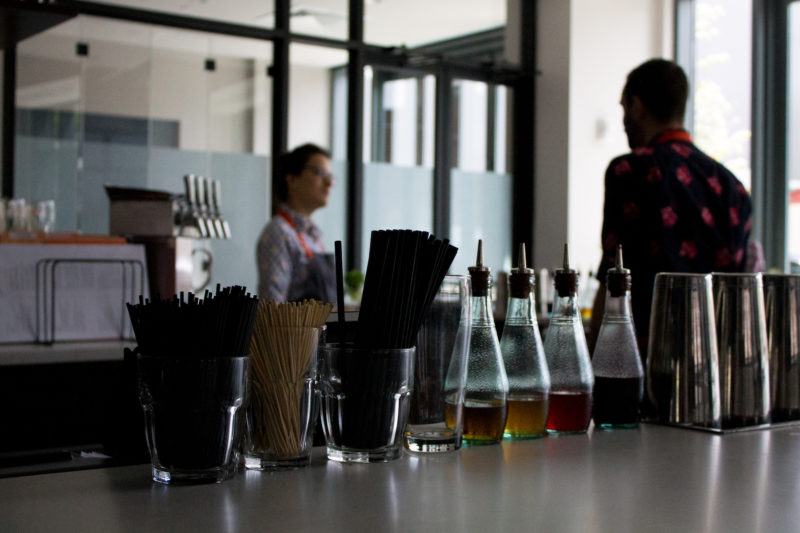
Was there discussion on how the theme of the program fits into the restaurant?
RYAN:
Absolutely. Jenna and I both come from really classic schools of cocktail thought. I was making cocktails at No. 9 Park for just about the past four years, working for Jackson Cannon. Jenna learned a lot working at Drink. Those places make what a lot of people would typically think of as the “craft cocktail.” When we were coming here, we wanted to reinterpret a lot of that and say “Yeah, this is a Martini variation, but it’s our variation on a Martini.”
We wanted to have more of a modern take, but with a lot of Italian ingredients. You’ll see in a lot of our cocktails that we take very simple formats and find ways to incorporate hallmarks of Italian cuisine or culture.
For instance, Italian palates are really tuned to the bitter flavor profile. Amari is such a hot word in the beverage community right now. But, in Italy, it’s really true. It’s why people in America don’t really like black licorice, because it’s really sweet flavor but also really bitter. It’s really polarizing. But, in Italy, you’re brought up with that flavor. You’re brought up with bitter as being something your palate will taste all the time.
So, you’ll see a lot of takes on cocktails that add bitter ingredients to the mix. You’ll also see a lot of cocktails that add things like chestnut honey that you don’t see too often in cuisines outside of Italy. We find ways to incorporate them into our beverage program.
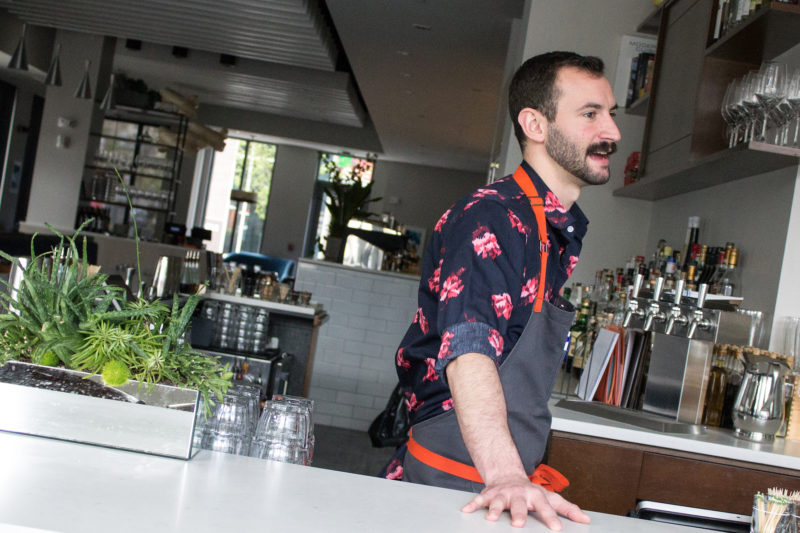
Do you feel like the creative process still happens now or has it settled down?
RYAN:
It’s never settled. This will be our third cocktail list change since we’ve opened, which is five less than we would have wanted to have at this point. It does take a long time. It’s a lot of work to write a cocktail list, to invent twelve cocktails. We went from No.9—where the list maybe had only four or five house cocktails and then everything else was really classic—to saying we don’t want to put any cocktails on this list that weren’t invented by someone here. Sometimes just the process of writing the ideas can take weeks and then testing it is a whole other story.
What was the biggest challenge with putting together a program from scratch?
JENNA:
All the things you take for granted that you forgot that you have to build. You’re just so used to things being there like having recipes for all of the classic cocktails to make sure we’re all being consistent. That, and remembering to ordering toothpicks. It’s all the fine details that are really easy to take for granted.
RYAN:
People have asked me what the hardest part of opening a restaurant has been and I have always said that it’s that everything is your first. There’s no historical context to pull from.
For example, when Jenna and I were building the spirits list, we treated it almost like we were going to be in a hotel, because we’re in this building with thousands of people living in it. We wanted to have a viewpoint, but we didn’t want to alienate people. So, we brought in all these products that we hadn’t had at other places where there was no need for them. They were craft cocktail bars, so no one was expecting us to have Jameson there. But, nobody ended up ordering them here after all. We still have some of them, but it was funny to put so much effort into that part of the process and have it be just “Oh, I guess we didn’t need that.”
JENNA:
This neighborhood is also being built as we speak. We can’t go off the neighbor and what they normally do, because the people coming in are still settling. The neighborhood itself is still trying to form its identity.
RYAN:
And we were the first. No one else was open.
JENNA:
So, it’s like we’re swept up into doing it with them, rather than in responding to them.
With the neighborhood being so untested, how did you do your research?
RYAN:
I’d like to say that we ate at every restaurant in a five mile radius and took notes on what they were doing, but that is absolutely not the case. The thing is we’ve all worked in this industry for a long time. It’s a small scene in Boston. The closest restaurant is Myers + Chang and Coppa after that. I’ve eaten at both of those places a million times.
We looked at a lot of places that were about to be opening or just opened in different cities, because it can become very insular in Boston. Here, you either learned from Jackson Cannon or John Gertsen. That’s pretty much the two big names that you see a lot. So, I always try to look outside the city as much as possible to see what other people are doing.
How did you go about building your opening team?
RYAN:
The toughest part of building out a team is that you kind of start from scratch with culture, which is really difficult. For Jenna and I, we were taking our hands from the coldest of water and putting it into the hottest of water, because we were coming from a place that’s been open for twenty years with a culture that is really strong and going to a brand new restaurant. The fact that Jenna and I had been working together for years did bring some amount of culture. At the very least, it would bring some consistency that people could see between the two of us.
I would like to say that I had some grand scheme of going to different places and finding bartenders that were great, but we had job interviews. We needed a certain amount of people who really knew how to bartend already and a certain amount of people who we thought we could teach and could learn along the way. With our reputation in this city, we had a couple great bartenders just pop out of the woodwork. We were really lucky that a mutual friend of ours, Josey Packard, decided she really wanted to come here a couple days a week. She had opened Drink and been there for a long time, so she was a great resource to have on the team.
It’s one of those things where you look for people who are going to be the right cultural fit and not just the best bartenders. As with every opening, you shed a few people along the way, but we’ve been lucky to keep most of our people. We haven’t had to hire any bartenders since we opened. We just like people who are nice.
When I first started hiring at Lineage, I was working for Jeremy Sewall, who just opened Les Sablons, and he always had a saying before we would interview people: “You can’t train nice.” It’s absolutely true. I can’t train people to be nice, but I can train anyone to make a cocktail. I can’t teach people to be how to be hospitable towards guests, to have the desire to be that way.
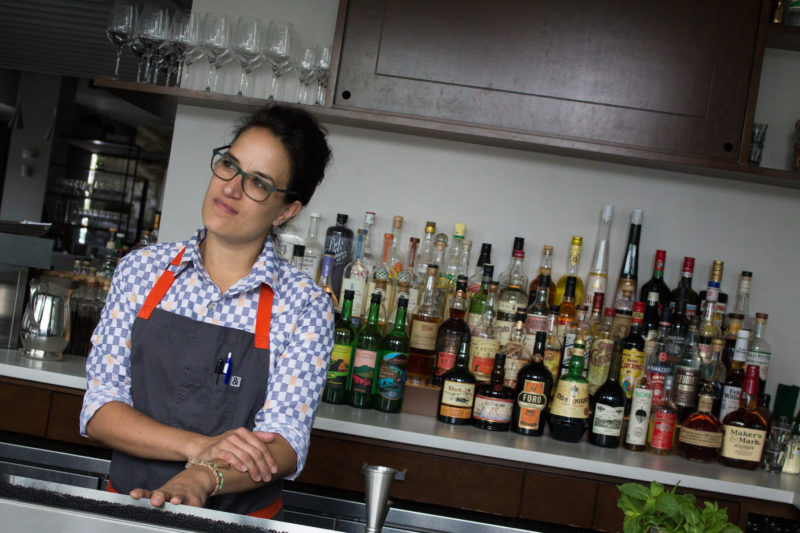
What is the one piece of advice you would give to someone starting their own program?
JENNA:
What is really important is to have a vision. You want to clarify it as much as you can and you want to roll with that. It gets murky if you try to do too many things. The things that really shine and stick out in the places that we know are really true to who they are and their identity. If you can keep a clear vision, it helps you make decisions along the way. People will also follow you, because they will understand what you’re trying to create.
RYAN:
Be a sponge. Read every book you can read. Read every cocktail list you can read. Look at every website you can look at. We live in a day and age where there is so much information available. You have to find a way to take it all in and filter it down. Like Jenna said, be clear about your own vision, because there is so much noise. There are so many different programs and so many different styles of bartending, but the successful ones have a very clear viewpoint.
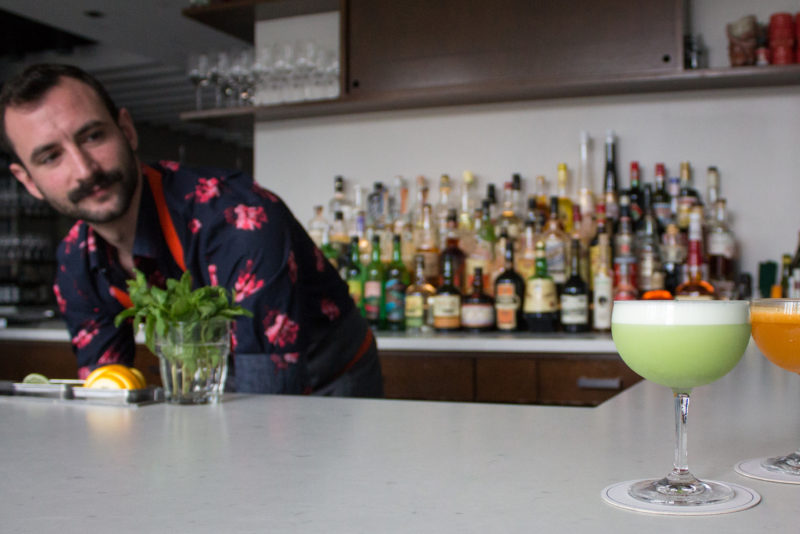
Make sure to check out some of Jenna and Ryan’s cocktail recipes at Bar Mezzana and get even more insight into how they developed them in our newest Craft Cocktail Book. For more industry spotlights and insights, stay tuned to the blog by creating your own free community account to get up-to-date notifications on new articles as well as gain access to exclusive resources.
Plus, check out the recipes here with additional photos from our private mixing session with Jenna and Ryan.
Schedule 15mins to chat with a product specialist
Start a FREE Trial Today! BevSpot offers full product education and account setup for all customers! No card Information needed!
The 10 Most-Ordered Beer Brands in New York City
The Big Apple is often seen as a modern-day Mecca when it comes to trends in the hospitality industry.
With this in mind, it comes to no surprise that the craft beer movement that has impacted the landscape throughout the country would already be felt here. New York City even plays host to a number of highly reputable breweries such as Brooklyn Brewery, Evil Twin, and Sixpoint. With countless world-class beer programs within the city, you would think that the ecosystem of beer in New York City would be as vibrant as its inhabitants.
Our data might say otherwise.
As a follow-up to our look at the top-selling liquor brands in NYC, we decided to aggregate the ordering data of our user base in the New York City metro area, which features dozens of bars. We took a hard look at their ordering habits when it pertains to beer and you’ll find a comprehensive look at the current beer landscape in the city that never sleeps.
The following material aggregates a year’s worth of ordering data ending in March 2017 from BevSpot users in the New York metropolitan area, as defined by the U.S. Census Bureau. All figures represent percentages of orders in dollar terms.
Crafting Cocktails: Jenna Rycroft’s ‘I‘iwi Bird
“Tiki” Cocktail Recipe
‘I‘iwi Bird*
Ingredients
- 2 oz Privateer Tiki Gin
- ½ oz Aperol
- ½ oz liliko’i (passion fruit) syrup
- ½ oz lime juice
Instructions
- Shake all ingredients with ice and serve up.
About the Drink
Jenna:
“In the past, I didn’t have much experience making cocktails. Ryan forced us, because he liked making us do things we didn’t like to do. This one started out of a small love affair that Ryan and I have with a local distiller named Maggie Campbell. She is Head Distiller–Vice President at Privateer, a rum distillery in Ipswich. A couple of years ago, Privateer came out with a gin—a tiki gin actually. It’s infused with a lot of tropical fruit notes along with gin botanicals. It’s a really unique product, really bold. So, I wanted to use that in my cocktail.
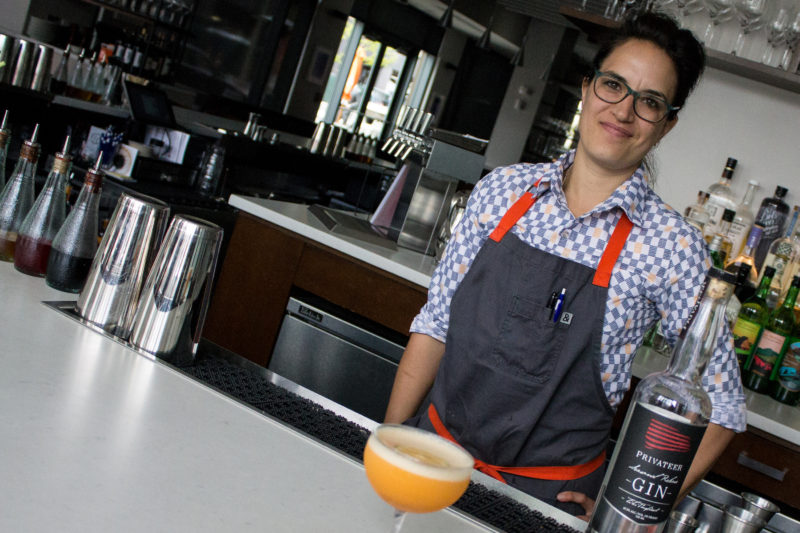
“The cocktail is called ‘I’iwi. It’s actually the Hawaiian word for a native bird known as the honeycreeper. I’m part Hawaiian, so I wanted to use this to recognize some of my culture. I was imagining this beautiful tropical bird when I made this cocktail.”
*Individually crafted cocktail brought to Bar Mezzana from previous location.
Crafting Cocktails: Ryan Lotz & Jenna Rycroft’s Peas and Thank You Recipe
Recipe
Peas and Thank You
Ingredients
- 1 egg white
- 1 ½ oz Citadelle gin
- ¾ oz lime juice
- ¾ oz snap pea syrup
- ½ oz Luxardo Bitter Bianco
- thyme sprig garnish
Instructions
- Add all ingredients to shaker and shake once without ice.
- Shake again vigorously with ice for about 30–45 seconds.
- Double strain and serve up.
- Garnish with sprig of thyme.
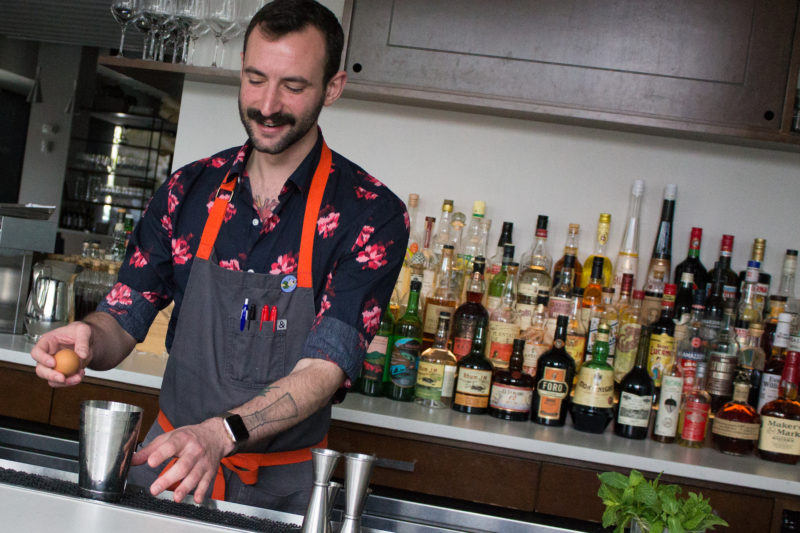
About the Drink
Ryan:
“For the fall/winter menu last year, we had a cocktail called the Carabinieri, which had matcha powder in it. There’s a thing I call ‘the Mojito effect.’ There are particular drinks that, when they hit the tray and get walked through the restaurant, all of a sudden everybody wants that drink. It’s often driven by color or garnish. It turns out that green cocktails have this incredible appeal, probably because you don’t see green in cocktails that often.
“When we were writing the spring menu, I thought this is probably the time to have a green drink, since we now have lots of green things available to us. I started thinking about what kinds of ingredients could possibly turn a drink green, snap peas being one of them. So, we made this really delicious snap pea syrup that has an incredible texture.
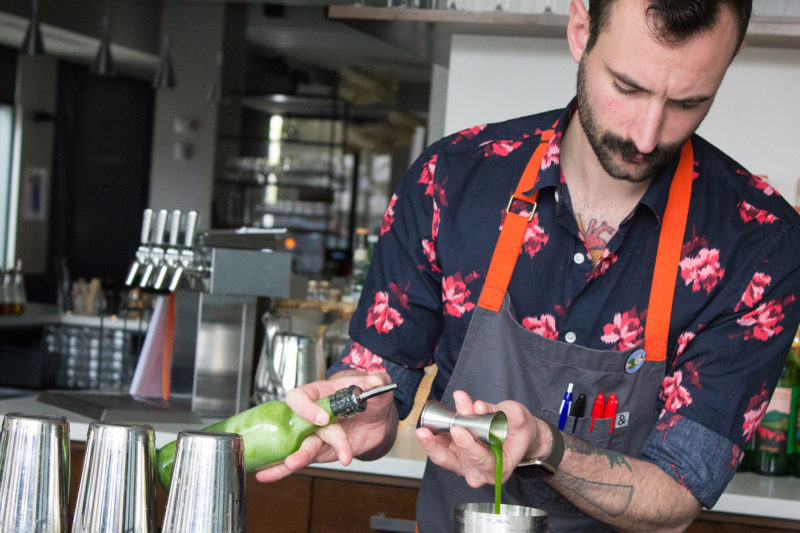
“Luxardo Bitter Bianco is a new product. A lot of times, when you want to add bitter notes to a drink, you have to add a lot of color. There are some clear bitter liqueurs that are really intense, but this is a mild bitter that has lots of orange notes to it. We’re also using Citadelle gin for this, which is made by the Pierre Ferrand distillery. It’s really mild and floral, just a really nice compliment to everything else going on.
“With egg white cocktails, they don’t normally carry a lot of aromatics, so we always like to put something on the top of the cocktail. A lot of times, it’s just a twist that you discard, so that you leave the foam looking beautiful. But, it’s always a nice point where you can make a decision that enhances the cocktail. Jenna and I were rummaging through the walk-in, trying to figure out what to put on top of the cocktail. We toyed with edible flowers and with pea greens. Then, we realized that thyme would smell really nice with the cocktail.”
Crafting Cocktails: Ryan Lotz & Jenna Rycroft’s Tropical Contact High
Recipe
Tropical Contact High
Ingredients
- 1 ½ oz Rhum J.M Agricole Blanc
- 1 oz lime juice
- 1 oz coconut cream
- ½ oz Meletti Anisette
- ½ oz Tequila Fortaleza Blanco
- ½ oz mint simple syrup
- crushed ice
Instructions
- Shake with a small handful of crushed ice briefly.
- Pour into tiki mug, top with crushed ice.
- Garnish with a lime wheel and whatever else you’ve got on hand that looks festive.
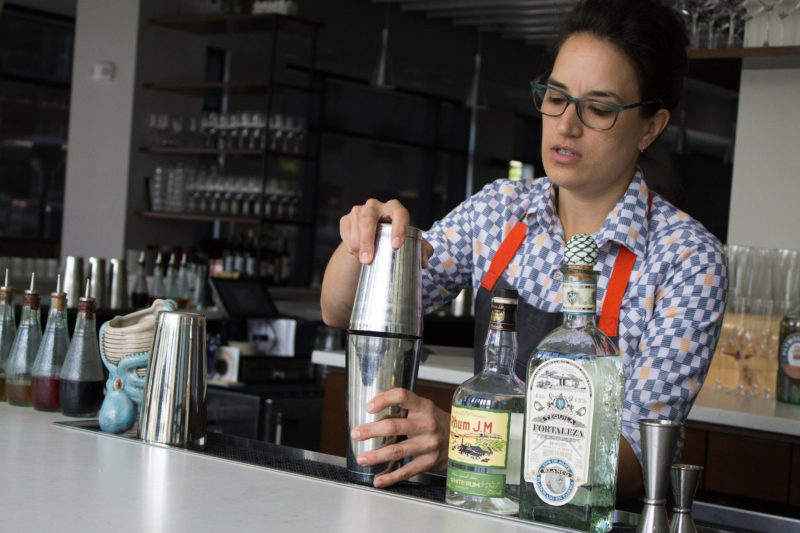
About the Drink
JENNA:
“Ryan just has a passion for tiki drinks. He wanted to do something with coconut cream, and I was like, ‘tell me if this is crazy: agricole, coconut, and anise.’ He’s looking at me for a minute, and, I’m thinking, ‘is this good or bad ’… and then he grins. That was the moment he fell back in love with me all over again.”
RYAN:
“I have four of those moments every day.
“The coconut cream is actually a collaboration between Jenna and I and one of our friends. Coconut cream is one of those ingredients that’s embarrassing how fake the canned stuff is. Well, not embarrassing exactly, because I love using it. It’s just a lot of work to make it from scratch. Jenna and I were searching high and low for a method to make better coconut cream. We ended up talking to our pastry chef at the time who’s still one of our best friends and is now the pastry chef at The Table at Season to Taste, Mary Edinger. She worked with us to develop the recipe that we use now. It’s a two-day process, but the end result is awesome.
“We take unsweetened coconut and we toast it. We then bring it up to a boil with sugar, water, and fat. We let that sit overnight in the fridge and strain it out through a cheesecloth. There’s so much coconut oil at this point that we let the oil solidify and pull it off the top. Then, we just mix together the toasted coconut syrup, which is, in of itself, a delicious cocktail ingredient, with Perfect Purée coconut purée. It adds a roasted coconut flavor and this extra layer of complexity.”
JENNA:
“The anisette brings us those anise notes. Our mint simple syrup is not necessarily to bring in mint, but it supports the other herbal notes. After we played with it, we needed something to give it some body, so we added Fortaleza blanco tequila. It’s oily and full, the kind of tequila I prefer honestly. We also used a higher proof white agricole, so it’s going to have those cool grassy and earthy notes too.”
Crafting Cocktails: Ryan Lotz & Jenna Rycroft’s Crossbred Instrument
Recipe
Crossbred Instrument
Ingredients
- 1 oz Cinzano Bianco Vermouth
- 1 oz Macchu Pisco
- 1 oz Citadelle gin
- 2 dash Bitter Queens NorCal Nancy Eucalyptus Bitters
- edible flower garnish
Instructions
- Stir all ingredients over ice in a chilled pitcher.
- Strain and serve up.
- Garnish with edible flower.
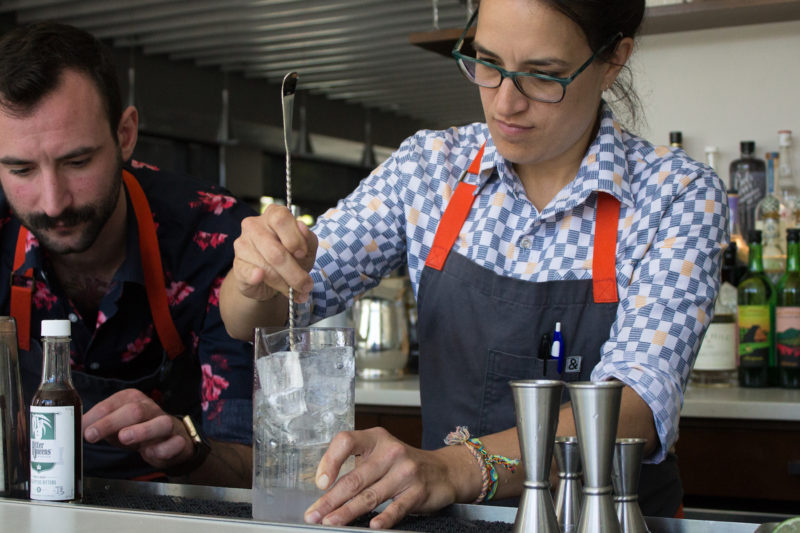
About the Drink
RYAN:
“When we were thinking of new ideas for the menu, I was looking for new products. I met this guy at Tales of the Cocktail who makes these really fun bitters called Bitter Queens. I just knew we had to have these in the South End. He has some basic orange bitters, but he also has Thai spice bitters, Chinese five-spice bitters, eucalyptus, and he gives each one a persona. For example, Thai spice is ‘Bangkok Betty.’ For this cocktail, we’re using the eucalyptus bitters, which is ‘NorCal Nancy.’ Bitter Queens is out of San Francisco, so it’s their hometown bitter.

“Jenna and I were talking about trying to do a cocktail that was a stirred pisco drink, because you rarely see pisco that’s used in any way other than shaken with citrus and usually an egg white. This is our take on a martini with pisco. We ended up deciding to go with a split between pisco and gin.
“There are times when Jenna and I are banging our heads against the wall for months trying to make a cocktail work. This was one of those cocktails where the first time was perfect, which never happens.”
Crafting Cocktails: Ryan Lotz’s Mezzana Spritz
Recipe
Mezzana Spritz*
Ingredients
- 2 oz soda water
- ¾ oz Campari
- ½ oz Combier Crème Pêche De Vigne
- Moscato d’Asti
- orange wheel garnish
- mint sprig garnish
Instructions
- Build first three ingredients over ice in a highball glass.
- Top with Braida Moscato d’Asti.
- Garnish with orange wheel and mint sprig.

About the Drink
Ryan:
“This cocktail is the only cocktail that has stayed on every menu that we’ve had. We named it after the restaurant. It’s a cocktail I started making at No. 9 as a total joke, because we had gotten a sample of this really awesome peach liqueur. It was a kind of bastardized ingredient, because it’s typically so fake, saccharine, and gross. This one peach liqueur from Combier we really loved, so I wanted to make use of it. One of the tasting notes you always hear about sparkling Moscato is peach, so I wanted to riff off of that. I wanted to do this bitter dessert wine cocktail with peach liqueur and different amaro.

“We were opening the restaurant and we wanted to have a spritz on the menu. We actually wanted to have a whole section of spritzes, because they are so iconic. What we decided to do was to take that cocktail I was making and add some Campari to balance out all the sweetness from the peach liqueur, and then top it off with some soda and Moscato.”
*Individually crafted cocktail brought to Bar Mezzana from previous location.
Hair of the Dog: On Welcoming Man’s Best Friend Into Your Bar
Since the dawn of time, where man goes, man’s best friend has followed. And now the local bar is the next frontier.
With summer around the corner, people are looking to get out and enjoy the improving weather. This is especially true of people and their dogs. And, while there are a number of traditional places one can escape with their dog, owners are always looking for someplace unique and new to take their pets on a day out. According to the APPA, nearly one in five businesses now allow pets in the workplace. The local dog friendly bar is quickly becoming a favorite spot for not just man, but man’s best friend.
Benefits of Man’s Best Friend
According to the Humane Society, there are 54.4 million households in America with a dog. For any bar or restaurant, that’s an enviable amount of potential patrons. Popular sites like Bring Fido both guide locals looking for a night out to dog friendly businesses and can serve as a great research tool to seek out those businesses around you who have already made the transition. This is especially true if you’re bar is already located near these places or local dog parks. Finding a strong local community of dog-lovers already in place goes a long way into making the transition smooth and successful. Make sure not only to get your name on lists like these, but reach out to other local dog-friendly spots to make sure they all know that you’re the local bar to visit.
An increase in business isn’t the only benefit to becoming dog-friendly. Improved atmosphere is high on the list as well. A dog-friendly bar offers a unique atmosphere that can’t be matched by more closed off locales. It’s memorable, and a point in the bar’s favor that may elevate them above similar businesses that don’t share the same open policy of allowing Spot and Fido on the premises.
This benefit extends to employees as well. According to the Humane Society, Fast Company, and Forbes, those working in a dog-friendly place of business are more likely to experience higher morale, lower stress, less incidence of illness, and provide better communication between themselves and customers. The presence of a pooch acts as an icebreaker and conversation starter, making the business a more friendly place.
Running With the Wolves
This isn’t to say that becoming a dog-friendly bar is all benefit, much as we would like it to be. There are a bevy of concerns and special circumstances to navigate when making the decision to go dog-friendly. First and foremost is the legality of such a move. While there is no hard and fast federal law with regards to allowing dogs into your establishment, regulations and rules vary from city to city.
The first major decision is how people with canine companions are going to be seated. Will your town allow them inside the building? Will they have to sit at an outdoor patio? If the former, should you have a separate area anyways so customers who are allergic or don’t wish to dine with the dogs can have an enjoyable night out?
Once you’ve got proper areas for everyone, the next hurdle is service. Many areas differ on whether the law allows for table service to a dog accompanied table. In areas where table service is disallowed, customers will have to order inside and take their own food and drink out to their table. This keeps wait staff away from the dogs and any allergens out of the kitchen. Even if table service is allowed in a bar’s area, asking customers to wait on themselves keeps the wait staff from tripping over leashes and from petting the dogs.
Next up on the list are cleanliness, and insurance. Let’s be honest. No matter how well trained the dog, at some point, nature will call. Setting aside an area where dogs can discreetly and sanitarily relieve themselves will keep the rest of the establishment clean. Having bags, cleaner, and separate disposal areas handy ensures a clean bar. Once you’ve got your space set and your rules in place, make sure to pick up insurance. While a well run and welcoming environment should preclude altercations between dogs, owners, and patrons etc., it never hurts to be prepared.
On Becoming Top Dog
Having successfully navigated the litany of hoops, codes, and regulations required of a dog-friendly bar, the next step is making sure that the experience is a memorable one for all your patrons, both two-legged and four. It starts with the basics, leaving out water bowls for the dogs. It’s an easy gesture, but one that we’ve hugely appreciated in our past visits to dog-friendly establishments.
Next up: food. Setting up a dog menu serves several purposes. First, it’s an extra source of income. Simple fare like cooked hamburger or chicken, cups of crushed ice, or a shot of whipped cream are both an exciting treat for the dog and a quick item to prepare. Second, it shows that your establishment is not just willing to allow dogs, but welcome them by making an effort to make sure they are cared for. Third, and perhaps most importantly, it lowers the odds of accidentally making a dog ill. Owners treat what their dogs eat as differently as if they were human children. Serving dog food only at their owner’s request keeps everyone safe and healthy. Finally, consider donating a portion of dog menu proceeds to worthwhile animal charities. A business that takes steps to care for not just the patrons and their animals who visit, but for animals all over, will leave a lasting impression on any customers.
One of the best ways to make dogs and their owners feel welcome and also to get the word out that your establishment is to hold special dog days or themed events. Setup giveaways for free merchandise or gift certificates to your establishment. Take pictures of your patrons and their furry friends and put them up on your social media accounts or on a special display. Host charity events that encourage patrons to not only attend but donate to worthy causes.
There are innumerable benefits to making your bar or restaurant a dog-friendly one. It drives new traffic in, and creates loyal customers who will spread word of an establishment where they can take their four-legged friends. It increases morale, and makes the work environment a more fun and relaxed place for your employees. True, it takes work and a working knowledge of city and state regulations, a plan for health and to keep the peace. But the rewards, the fun, the gain to be had is worth it. According to the Humane Society, 63% of pet owners consider their animals not just companions, but members of the family. Treat them as such, and they’ll be as loyal to you as man’s best friend is to them.
For more helpful articles on bar management, make sure to create your own BevSpot community account to stay informed on the latest articles and gain exclusive access to resources and guides.
Schedule 15mins to chat with a product specialist
Start a FREE Trial Today! BevSpot offers full product education and account setup for all customers! No card Information needed!


